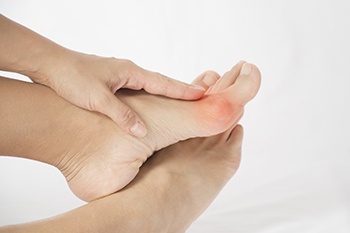
 A very common foot condition that causes a bony lump to appear on the base of the big toe is known as a bunion. Bunions occur because the joint is pulled out of alignment, causing the big toe to turn towards the rest of the toes. Bunions tend to worsen over time and common symptoms can include a deformity in the joint of the big toe, a bony lump, pain, redness, swelling, or an overlapping of the big toe over the smaller toes. Bunions can have a variety of causes, such as wearing shoes that don’t fit correctly, arthritis, old age, and even genetics. Bunions can be treated both surgically or non-surgically through methods such as orthotics, or pain relief medicine. If you are experiencing a painful bunion, consulting with a podiatrist is suggested in order to find a treatment method that is best for you.
A very common foot condition that causes a bony lump to appear on the base of the big toe is known as a bunion. Bunions occur because the joint is pulled out of alignment, causing the big toe to turn towards the rest of the toes. Bunions tend to worsen over time and common symptoms can include a deformity in the joint of the big toe, a bony lump, pain, redness, swelling, or an overlapping of the big toe over the smaller toes. Bunions can have a variety of causes, such as wearing shoes that don’t fit correctly, arthritis, old age, and even genetics. Bunions can be treated both surgically or non-surgically through methods such as orthotics, or pain relief medicine. If you are experiencing a painful bunion, consulting with a podiatrist is suggested in order to find a treatment method that is best for you.
If you are suffering from bunion pain, contact Dr. Alan J. Spector of Shore Podiatry. Our doctor can provide the care you need to keep you pain-free and on your feet.
What Is a Bunion?
Bunions are painful bony bumps that usually develop on the inside of the foot at the joint of the big toe. As the deformity increases over time, it may become painful to walk and wear shoes. Women are more likely to exacerbate existing bunions since they often wear tight, narrow shoes that shift their toes together. Bunion pain can be relieved by wearing wider shoes with enough room for the toes.
Causes
Symptoms
In order to diagnose your bunion, your podiatrist may ask about your medical history, symptoms, and general health. Your doctor might also order an x-ray to take a closer look at your feet. Nonsurgical treatment options include orthotics, padding, icing, changes in footwear, and medication. If nonsurgical treatments don’t alleviate your bunion pain, surgery may be necessary.
If you have any questions, please feel free to contact our office located in Point Pleasant, NJ . We offer the newest diagnostic and treatment technologies for all your foot care needs.